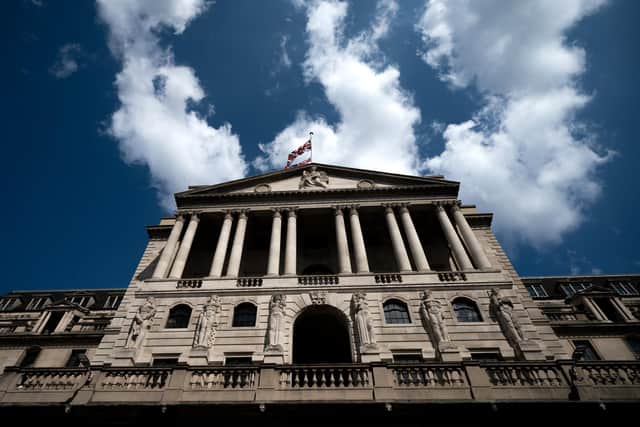Interest rates: Why the Bank of England is playing the waiting game and the likely date for a first cut
Few expected the Bank of England to kick off its rate-cutting programme this side of Easter, despite the continuing positive news on the inflation front, so attention naturally turns to when that first strike is likely to be made.
In one of the clearest signs in recent months that a cut could be imminent, the bank’s governor Andrew Bailey said that while the UK economy is “not yet at the point” where rates can be lowered, things are “moving in the right direction”. And, tellingly, for the first time since September 2021, no-one on the nine-person decision-making body that sets interest rates voted for an increase. Cue the inevitable predictions for an initial rate cut “by the summer”, “in early summer” or even as optimistically as May 9, at the bank’s next rate-setting meeting.
Advertisement
Hide AdAdvertisement
Hide AdHowever, there is a growing frustration among many in the business community, and certainly among those in the property world, at the UK central bank’s inaction, particularly in light of its eagerness to hike rates month after month when inflation was proving sticky. Critics have also pointed out that those inflationary pressures were largely of a global nature, triggered by soaring energy costs, and beyond the direct control of the nine learned members that make up the monetary policy committee (MPC).


The one-trick approach has involved using higher interest rates to try and control an inflationary backdrop caused mainly by supply-side issues, energy costs and soaring food prices. In contrast to previous spending-fuelled inflationary bubbles, people this time round have simply been forking out more to buy the same basic goods and services, and pay for the roof over their heads, putting the squeeze on any discretionary spending.
The Bank of England’s inertia came as Switzerland’s central bank led the way for major western economies by making a surprise quarter-point cut in interest rates, to 1.5 per cent. The UK base rate, on the other hand, remains at 5.25 per cent, for the time being, following the 8-1 majority vote to hold. MPC members Jonathan Haskell and Catherine Mann had at the last meeting argued that rates should rise to 5.5 per cent, but they have now joined the majority to vote for 5.25 per cent. One member of the committee, Swati Dhingra, voted to trim rates to 5 per cent, repeating her vote from the previous month.
Alastair Douglas, chief executive of TotallyMoney, said: “Next Tuesday marks four years since the first coronavirus lockdown, and for many, four years of financial misery. And although [Wednesday’s] headlines celebrated the slowing of inflation, and the Chancellor claimed ‘the plan is working’, this week’s data also showed that unemployment has risen to 3.9 per cent, business insolvencies have increased by a third, and 6.7 million people are now in financial difficulty.
“The Bank of England was slow to increase interest rates, and there’s a growing worry that it’s taking too long to bring them back down. High rates are forcing homeowners into arrears, stifling economic growth, and creating a credit crunch for the most vulnerable. Things which won’t just impact lives now, or until the rate cut happens, but for the foreseeable future.”


Tobias Gruber, chief executive of My Community Finance, said: “I must admit feeling a bit disheartened by the Bank of England’s decision not to cut interest rates, especially when inflation is creeping closer to the 2 per cent target faster than anticipated. The recent findings from Debt Justice paint a stark reality of Britain’s financial landscape, with a record-breaking 6.7 million individuals currently grappling with financial difficulty amidst the escalating cost of living crisis.”
Figures released on Wednesday by the Office for National Statistics showed that the annual rate of inflation had fallen to 3.4 per cent in February, its lowest point since 2021. But that data also showed that inflation in the services sector, in the bank’s words, “remains elevated at 6.1 per cent”. And despite the cooling in the headline rate, “key indicators of inflation persistence remained elevated”, the Bank added.
So, for millions of hard-pressed borrowers and businesses the waiting game continues, with most experts anticipating a rate cut in June (MPC meeting on 20th), or at the latest August (1st). That is likely to trigger a series of further small reductions in subsequent months.
Advertisement
Hide AdAdvertisement
Hide AdAndy Mielczarek, founder and chief executive of SmartSave, a Chetwood Financial company, said: “The Bank of England has not bowed to pressure to cut rates in recent months, and it is likely to still be wary of a potential uptick in inflation thanks to tax cuts and minimum wage rising in the coming months. Interest rates will come down soon enough, with most experts anticipating a cut in June, or at the latest August. But this won’t mean blue skies all around. While higher interest rates remain a major issue for debtors and mortgage holders, the cost of living is still untenable for many households thanks to slowing wage growth and prices – especially for food – still rising.”
Joe Nellis, MHA’s economic advisor and professor of global economy, Cranfield School of Management, said May could be a possibility for a cut, adding: “There are likely to be at least two additional cuts in interest rates this year after the initial cut in May or June. Interest rates are likely to normalise at around 3.5 to 4 per cent by the beginning of 2025, but they will not be falling to the record lows enjoyed by borrowers in previous years.”
Comments
Want to join the conversation? Please or to comment on this article.